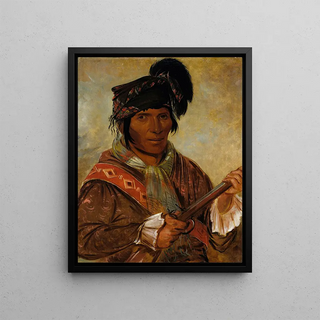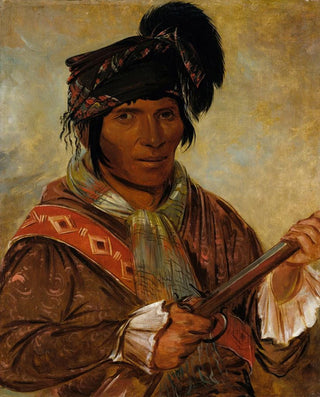Art print | Co-Ee-H-Jo a chief - George Catlin


View from behind

Frame (optional)
In the rich and complex panorama of American art history, the art print "Co-Ee-H-Jo un chef" by George Catlin stands out for its ability to capture the essence of a culture in full transformation. This painting, imbued with nostalgia for a bygone era, allows the viewer to immerse themselves in the universe of Native American tribes, while revealing the perspective of an artist passionate about preserving their heritage. Through this art print, one feels a deep connection with the past, an invitation to explore the stories and traditions that have shaped the identity of Indigenous peoples of America.
Style and uniqueness of the artwork
George Catlin's style is characterized by a blend of realism and romanticism, where every detail is carefully highlighted. In "Co-Ee-H-Jo un chef," the artist depicts a Native American chief with such precision that one can almost hear the whisper of his story. The vibrant colors and delicate textures of the painting evoke the richness of traditional costumes, while the expression of the chief conveys ancestral wisdom. Catlin does not merely reproduce an image; he creates an atmosphere, an ambiance that transports the viewer to the heart of the rituals and beliefs of these communities. This painting is much more than a simple visual representation; it is a living testimony to the dignity and strength of Native American cultures.
The artist and his influence
George Catlin, often regarded as a pioneer of American art, dedicated his life to documenting the lifestyles of Indian tribes. His work is the result of a deep commitment to preserving these cultures, often threatened by colonial expansion. Catlin traveled across the country, creating portraits and scenes of daily life, while striving to capture the soul of these peoples. His influence extends beyond his era, inspiring many artists and historians who see in him a precursor to the cultural conservation movement. Through his work, future generations gained access to an authentic vision of the Native Americans, enabling them to better understand and appreciate the diversity of their heritage.

Matte finish

View from behind

Frame (optional)
In the rich and complex panorama of American art history, the art print "Co-Ee-H-Jo un chef" by George Catlin stands out for its ability to capture the essence of a culture in full transformation. This painting, imbued with nostalgia for a bygone era, allows the viewer to immerse themselves in the universe of Native American tribes, while revealing the perspective of an artist passionate about preserving their heritage. Through this art print, one feels a deep connection with the past, an invitation to explore the stories and traditions that have shaped the identity of Indigenous peoples of America.
Style and uniqueness of the artwork
George Catlin's style is characterized by a blend of realism and romanticism, where every detail is carefully highlighted. In "Co-Ee-H-Jo un chef," the artist depicts a Native American chief with such precision that one can almost hear the whisper of his story. The vibrant colors and delicate textures of the painting evoke the richness of traditional costumes, while the expression of the chief conveys ancestral wisdom. Catlin does not merely reproduce an image; he creates an atmosphere, an ambiance that transports the viewer to the heart of the rituals and beliefs of these communities. This painting is much more than a simple visual representation; it is a living testimony to the dignity and strength of Native American cultures.
The artist and his influence
George Catlin, often regarded as a pioneer of American art, dedicated his life to documenting the lifestyles of Indian tribes. His work is the result of a deep commitment to preserving these cultures, often threatened by colonial expansion. Catlin traveled across the country, creating portraits and scenes of daily life, while striving to capture the soul of these peoples. His influence extends beyond his era, inspiring many artists and historians who see in him a precursor to the cultural conservation movement. Through his work, future generations gained access to an authentic vision of the Native Americans, enabling them to better understand and appreciate the diversity of their heritage.






